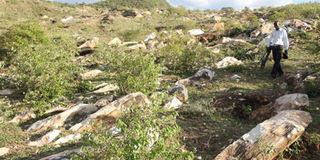At last, a cement plant for the Rift

PHOTO | JARED NYATAYA A man walks in a field with deposits of limestone at Ortum, along the Kapenguria-Lodwar Road, in West Pokot County. Construction of the Sebit cement factory is expected to begin soon.
What you need to know:
- Project will directly employ 1,200 people, and benefit over 40,000 others
- According to Cemtech Limited, the investor, construction at Sebit Village could begin in the next two weeks.
After years of uncertainty, an investor has finally committed to put up a cement factory to exploit the vast limestone deposits in West Pokot whose worth is projected in billions of shillings.
According to Cemtech Limited, the investor, construction at Sebit Village could begin in the next two weeks.
“We will set up base in the next 10 to 14 days. Locally-contracted companies for electrical and other works are already on site,” Cemtech director Rajesh Rawal told Sunday Nation.
The factory is scheduled to be completed in about one and half years, with cement production expected to begin in 24 months. Annual production is projected at 24 million bags.
Mr Rawal said the company has obtained the requisite certification from the Kenya Investment Authority, exclusive mining rights for limestone for 99 years from the West Pokot County government, and an Environmental Impact Assessment license from National Environment Management Authority.
West Pokot County deputy governor Titus Lotee confirmed the investor had been cleared to start works and tipped the project to make a bold statement that the county is opening up economically.
“The factory will play a big role in alleviating poverty and illiteracy through the establishment of schools – to which pupils and students will benefit from sponsorships from the investor – water pipelines, health facilities, as well as an infrastructural network to cater for residents,” he said.
The Sh12-billion project on 650 acres has been well received by locals. Feasibility studies conducted by the Kerio Valley Development Authority identified large deposits of limestone at the Ortum-Sebit area in Pokot Central District, enough to produce 300,000 tonnes annually.
Studies further indicate that the region is endowed with more than 35 other minerals, including gold, rubies and other gemstones.
As part of the project, the investor will put up a 30-megawatt power plant; 15 MW will be used by the factory, and the rest to be channelled to the national grid.
The coal required to fuel the manufacture of clinker, a main ingredient in cement, will come from fields yet to be mined in Kitui.
Musa Lokeyo, the father of four who attended the groundbreaking exercise in 2010, told Sunday Nation he had begun to give up hope. Two of his children dropped out of school, He hopes that if he finds a job at the factory, he can send them back to school.
“I expect that there will be a lot of jobs. I hope I will be among those who find employment,” he said.
Young people also have a placed a great deal of hope in the project.
“The company will not only earn us money but also keep youth engaged and busy. People engage in cattle rustling because they are idle and unemployed,” said Geoffrey Kiptum.
In 1997, Kavee Quarries began mining limestone in near Ortum centre. Residents demanded a cement factory, but the company cited lack of proper infrastructure and electricity and closed shop in 2006. The Sebit factory is expected to directly employ about 1,200 people and benefit another 40,000 residents of the arid region indirectly.




